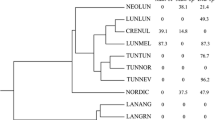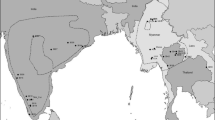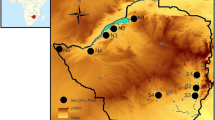Abstract
The genetic population structure inBdallophyton bambusarum, an endoparasite, was studied in ten subpopulations from a subdeciduous tropical forest in Veracruz Mexico. The sample was analyzed using seven polymorphic loci in cellulose acetate electrophoresis. Isozyme data indicated that the subpopulations ofB. bambusarum contained high genetic variability (Hep = 0.452 ± 0.045, S.E.). Our analysis suggests that almost each inflorescence ofB. bambusarum is an individual. The subpopulations studied were genetically similar (average Nei's genetic identity 0.941 ± 0.051 and F st values 0.097 ± 0.026), suggesting that genetic differentiation among subpopulations was small. Direct estimates of effective population size was derived from observations of three fluorescent dyes, and from the genetic neighborhood area derived from these data. The neighborhood area, multiplied by the total density of individuals, gave an Ne = 124.84 plants, and when corrected to consider the proportion of males and females gave an Ne = 118.59 individuals. An indirect estimate of Nm was obtained from the F st values (mean Nm=2.037), giving an indirect estimate of the effective population size Nb = 12.8 individuals. Both values are relatively high when compared to other plant studies. The gene flow and/or effective populations size of the studied subpopulations ofB. bambusarum are believed to be large enough to prevent differentiation among subpopulations due to genetic drift.
Similar content being viewed by others
References
Beaman, R. S., Decker, P. J., Beaman, J. H., 1988: Pollination ofRafflesia (Rafflesiaceae). — Amer. J. Bot.75: 1148–1162.
Beattie, A. J., Culver, D. C., 1979: Neighborhood size inViola. — Evolution33: 1226–1229.
Blain, D., Kellman, M., 1991: Effect of water supply on tree seed germination and seedling survival in a tropical seasonal forest in Veracruz, Mexico. — J. Trop. Ecol.7: 69–83.
Borchsenius, F., Olesen, J. M., 1990: The amazonian root holoparasiteLophophytum mirabile (Balanophoraceae) and its pollinators and herbivores. — J. Trop. Ecol.6: 501–505.
Burt, W. H., Grossenheider, R. P., 1976: A field guide to the mammals. — Boston, Massachusetts: Houghton Mifflin.
Cavalli-Sforza, L. L., Menozzi, P., Piazza, A., 1994: The history and geography of human genes. — Princeton, New Jersey: Princeton University Press.
Crawford, T. J., 1984: What is a population? — InShorrocks, B., (Ed.): Evolutionary ecology, pp. 135–173. — Oxford: Blackwell.
Crow, J. F., Aoki, K., 1984: Group selection for a polygenic behavioral trait: estimating the degree of population subdivision. — Proc. Natl. Acad. Sci. USA81: 6073–6077.
Dieringer, G., Werth, C. R., 1994: Population genetic structure ofAgalinis strictifolia (Scrophulariaceae). — Bull. Torrey Bot. Club121: 148–153.
Eastel, S., Boussy, I. A., 1987: A sensitive and efficient isoenzyme technique for small arthropods and other invertebrates. — Bull. Entomol. Res.77: 407–415.
Eguiarte, L. E., 1990: Genética de poblaciones deAstrocaryum mexicanum Liebm. en los Tuxtlas, Veracruz. — Ph.D. Thesis, Centro de Ecología, UACPyP, UNAM, México, D.F.
, Pérez-Nasser, N., Piñero, D., 1992: Genetic structure, outcrossing rate and heterosis inAstrocaryum mexicanum (tropical palm): implications for evolution and conservation. — Heredity69: 217–228.
, Búrquez, A., Rodríguez, J., Martínez-Ramos, M., Sarukhán, J., Piñero, D., 1993: Direct and indirect estimates of neighborhood and effective population size in a tropical palm,Astrocaryum mexicanum. — Evolution47: 75–87.
Ellstrand, M. C., 1992: Gene flow among seed plant populations. — New Forests6: 241–256.
García-Franco, J. G., 1996: Biología deBdallophyton bambusarum Liebm. (Rafflesiaceae). — Ph.D. Thesis, Facultad de Ciencias, UNAM, México, D.F.
, Rico-Gray, V., 1996a: Distribution and host specificity in the holoparasiteBdallophyton bambusarum (Rafflesiaceae) in a tropical deciduous forest in Veracruz, Mexico. — Biotropica28: 759–762.
, 1996b: Dispersión, viabilidad, germinación y banco de semillas deBdallophyton bambusarum (Rafflesiaceae). — Revista Biol. Trop.44: 87–94.
, 1997: Reproductive biology ofBdallophyton bambusarum (Rafflesiaceae). — Bot. J. Linn. Soc.123: 237–247.
Hamrick, J. L., 1987: Gene flow and distribution of genetic variation in plant populations. — InUrbanska, K., (Ed.): Differentiation patterns in higher plants, pp. 53–67. — New York: Academic Press.
Harris, H., Hopkinson, D. A., 1976: Handbook of enzyme electrophoresis in human genetics. — New York: Elsevier.
Hartl, D. L., 1980: Principles of population genetics. — Sunderland, Massachusetts: Sinauer.
Hebert, P. D. N., Beaton, M. J., 1993: Methodologies for allozyme analysis using cellulose acetate electrophoresis. — Beumont, Texas: Helena Laboratories, Inc.
Hedrick, P. W., 1983: Genetics of populations. — Boston, Massachusetts: Science Books International.
Hermanutz, L. A., Innes, D. J., Weis, I. M., 1989: Clonal structure of arctic dwarf birch (Betula glandulosa) at its northern limit. — Amer. J. Bot.76: 755–761.
Hillis, D. M., Huelsenbeck, J. P., Cunningham, C. W., 1994: Application and accuracy of molecular phylogenies. — Science264: 671–677.
Ines, D. J., 1990: Microgeographic genetic variation in the haploid and diploid stages of the mossPolytrichum juniperium. — Heredity64: 331–340.
Izquierdo, L. Y., 1995: Estructura y variación genética en cuatro especies deAechmea (Bromeliaceae) en México:A. mexicana (Baker),A. lueddemannian (K. Koch)Brong. exMez,A. macvaughii L. B. Smith yA. tuitensis (P. Magaña yE. Lott). — Ph.D. Thesis, Centro de Ecología, UACPyP, UNAM, México, D.F.
Kellman, M., 1990: Root proliferation in recent and weathered sandy soils from Veracruz, México. — J. Trop. Ecol.6: 355–370.
Kuijt, J., 1969: The biology of parasitic flowering plants. — Berkeley, Los Angeles, California: University of California Press.
Li, C. C., Horvitz, D. G., 1953: Some methods of estimating the inbreeding coefficient. — Amer. J. Human Genet.5: 107–117.
Linhart, Y. B., 1984: Genetic variability in the dwarf mistletoesArceuthobium vaginatum subsp.cryptopodum andA. americanum on their primary and secondary hosts. — InHawksworth, F. G., Scharpf, R. F., (Eds): Biology of dwarf mistletoes, pp. 36–39. — U.S.D.A. Forest Service: General Technical Reports RM-11.
Maynard Smith, J., Smith, N., O'Rourke, M., Spratt, B. G., 1993: How clonal are bacteria?. — Proc. Natl. Acad. Sci. USA90: 4384–4388.
Meijer, W., 1993:Rafflesiaceae. — InKubitzki, K., (Ed.): The families and genera of vascular plants. 2. Flowering plants. Dicotyledons, pp. 557–563. — Berlin Heidelberg, New York: Springer.
Meijer, W., Elliot, S., 1990: Taxonomy, ecology and conservation ofRafflesia kerri Meijer in southern Thailand. — Nat. Hist. Bull. Siam Soc.38: 117–133.
Moreno-Casasola, P., 1982: Ecologia de la vegetación de dunas costeras: factores físicos. — Biótica7: 577–602.
,van derMaarel, E., Castillo, S., Huesca, M. L., Pisanty, I., 1982: Ecología de la vegetación de dunas costeras: estructura y composición en el Morro de la Mancha, Ver. — Biótica7: 491–526.
Murawski, D. A., Hamrick, J. L., 1990: Local genetic and clonal structure in the tropical terrestrial bromeliad,Aechmea magdalenae. — Amer. J. Bot.77: 1201–1208.
Nei, M., 1978: Estimation of average heterozygosity and genetic distance from a small number of individuals. — Genetics89: 583–590.
, 1987: Molecular evolutionary genetics. — New York: Columbia University Press.
Novelo, A., 1978: La vegetación de la Estación Biológica el Morro de la Mancha, Veracruz. — Biótica3: 140–143.
Parra, V., Vargas, F., Eguiarte, L. E., 1993: Reproductive biology, pollen and seed dispersal, and neighborhood size in the hummingbird pollinatedEcheveria gibbiflora (Crassulaceae). — Amer. J. Bot.80: 153–159.
Peakall, R., Beattie, A. J., 1996: Ecological and genetics consequences of pollination by sexual deception in the orchidCaladenia tentactulata. — Evolution50: 2207–2220.
Pérez-Nasser, N., Eguiarte, L. E., Piñero, D., 1993: Mating system and genetic structure of the distylous tropical treePsychotria faxlucens (Rubiaceae). — Amer. J. Bot.80: 45–52.
Ramírez, F., García, G., 1990: Estructura y composición florística de la selva costera en La Mancha, Ver. — In: Congreso Mexicano de Botánica. Programas y Resúmenes, p. 188. — Oaxtepec, Morelos, México: Sociedad Botánica de México, A. C.
Richards, A. J., 1986: Plant breeding systems. — London: Unwin Hyman.
Rico-Gray, V., Lot-Helgueras, A., 1983: Producción de hojarasca del manglar de la Laguna de la Mancha, Veracruz, México. — Biótica8: 295–301.
Rutherford, R. J., 1970: The anatomy and cytology ofPilostyles thurberi Gray (Rafflesiaceae). — Aliso7: 263–288.
Sánchez-Colón, S., Ornelas de Anda, J. L., 1990: Multivar. Un paquete de programas para análisis multivariado aplicado a la ecología. — México, D. F.: Laboratorio de Ecología Vegetal, Escuela Nacional de Ciencias Biológicas, I.P.N.
Slatkin, M., 1993: Isolation by distance in equilibrium and non-equilibrium populations. — Evolution47: 264–279.
, 1994: Gene flow and population structure. — InReal, L. A., (Ed.): Ecological genetics, pp. 3–17. — Princeton, New Jersey: Princeton University Press.
, Barton, N. H., 1989: A comparison of three indirect methods for estimating average levels of gene flow. — Evolution43: 1349–1368.
Sokal, R. R., Rohlf, F. J., 1995: Biometry. 3rd edn. — New York: Freeman.
Souza, V., Nguyen, T., Hudson, R. D., Piñero, D., Lenski, R. E., 1992: Hierarchical analysis of linkage disequilibrium inRhizobium populations: evidence for sex? — Proc. Natl. Acad. Sci. USA89: 8389–8393.
Swofford, D. L., Selander, R. B., 1981: BIOSYS-1: a FORTRAN program for the compressive analyses of electrophoretic data in population genetics and systematic. — J. Heredity72: 281–283.
Tybayrenc, M., Ayala, F. J., 1991: Toward a population genetics of microorganisms? The clonal theory of parasitic protozoa. — Parasitol. Today7: 228–232.
Weider, J. L., Hebert, P. D. N., 1987: Ecological and physiological differentiation among low-arctic clones ofDaphnia pulex. — Ecology68: 188–198.
Workman, P. L., Niswander, J. L., 1970: Population studies on southwestern Indian tribes. II. Local genetic differentiation in the Papago. — Amer. J. Human Genet.22: 24–49.
Wright, S., 1992: Coefficients of inbreeding and relationship. — Amer. Naturalist56: 330–338.
, 1943a: Isolation by distance. — Genetics28: 114–138.
, 1943b: An analysis of local variability in flower color inLinanthus parryae. — Genetics28: 139–156.
, 1946: Isolation by distance under diverse systems of mating. — Genetics31: 39–59.
, 1951: The genetic structure of populations. — Ann. Eugenics15: 323–354.
Wynne, I. R., Losdale, H. D., Brookes, C. P., 1992: Use of a cellulose acetate system for allozyme electrophoresis. — InBerry, R. J., Crawford, T. J., Hewitt, G. M., (Eds): Genes in ecology, pp. 494–499. — Oxford: Blackwell.
Author information
Authors and Affiliations
Corresponding author
Rights and permissions
About this article
Cite this article
García-Franco, J.G., Souza, V., Eguiarte, L.E. et al. Genetic variation, genetic structure and effective population size in the tropical holoparasitic endophyteBdallophyton bambusarum (Rafflesiaceae). Pl Syst Evol 210, 271–288 (1998). https://doi.org/10.1007/BF00985672
Received:
Revised:
Accepted:
Issue Date:
DOI: https://doi.org/10.1007/BF00985672




